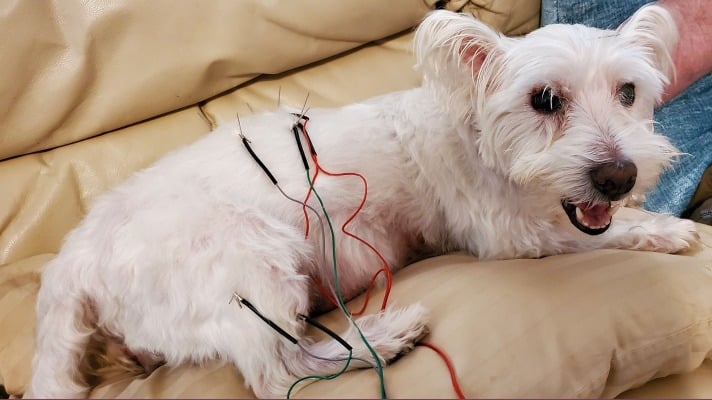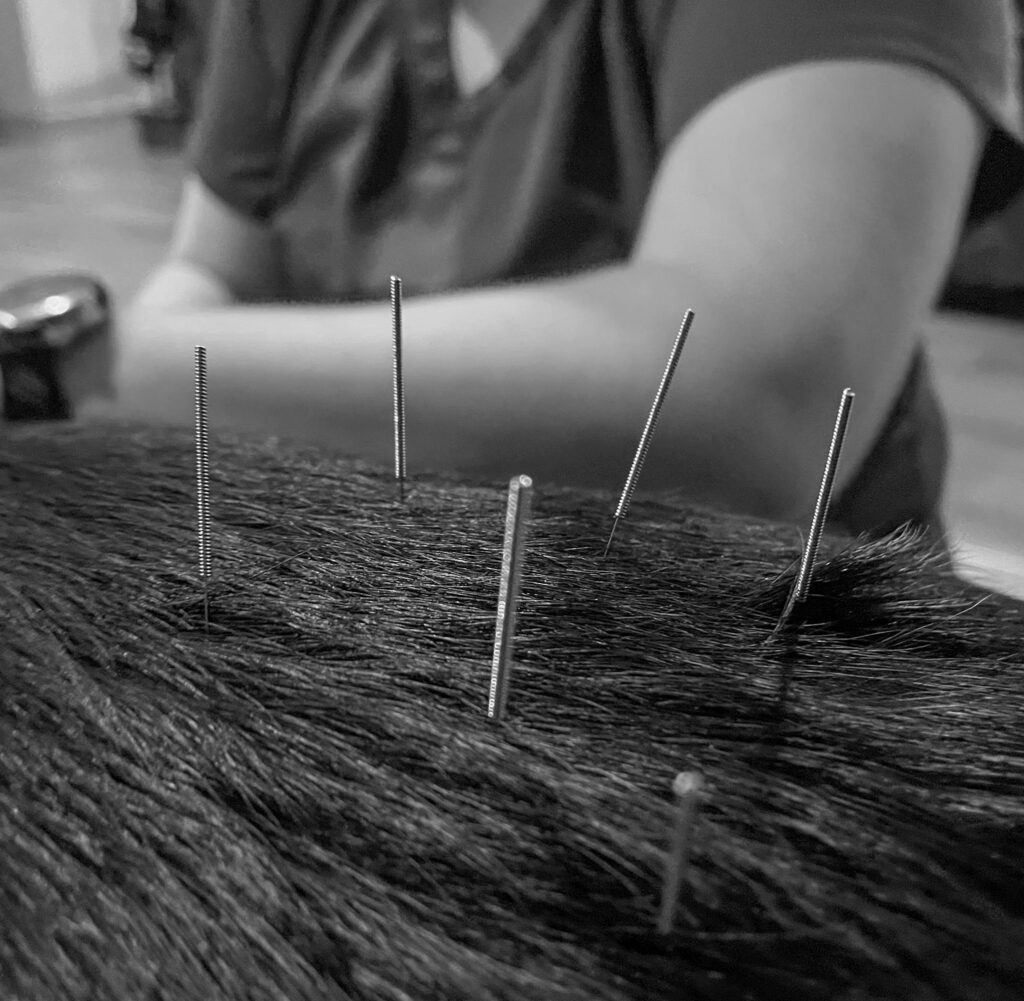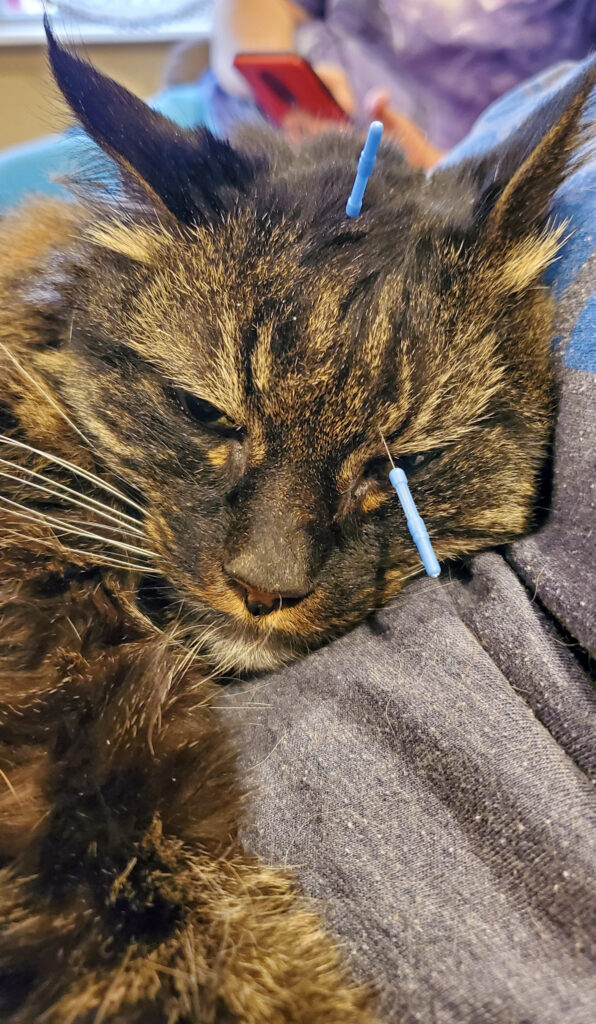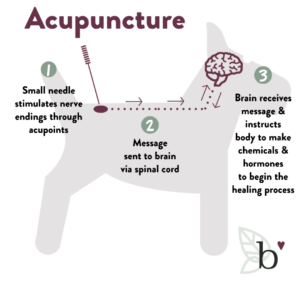Acupuncture
Considered to be a form of treatment for horses and livestock in China approximately 3000 years ago, veterinary acupuncture has expanded considerably since then to include multiple types of species and has been used all over the world for a variety of medical conditions.
Stemming from the Latin words “acus” (needle) and “pungare” (to pierce), acupuncture is defined as the use of solid-state sterile needles on acupoints located along meridians (also known as channels) on the exterior surface of the body in order to induce therapeutic effects.
How Does Veterinary Acupuncture Work?
Acupuncture has been studied by thousands of Chinese medical physicians (and veterinarians) over many centuries and the following is an abbreviated TCVM explanation of how acupuncture is thought to work in our veterinary patient’s bodies:
Meridians
There are 14 major meridians (or channels) used in acupuncture, 12 of which are bilateral (on both sides or halves of the body) and 2 of which are located on the top (dorsal) and bottom (ventral) portion of our animal patients.
- Each meridian represents an underlying TCVM organ or organ system(s). Examples include the Spleen meridian or Governing Vessel meridian.
- Meridians are paired together and due to their relationships, are thought to interact with one another. An example of this would be the TCVM Spleen being paired with its partner, the TCVM Stomach. This relationship can be analogous to a partner and their spouse: when one partner is weak, suffering, or affected by disease, the other is also affected and/or is able to provide support.
Qi
Along each meridian are a varying number of acupoints (or depressions/holes) where Qi (pronounced “Chee”) gathers.
- Qi can be defined as the life force (or a form of vital energy) which can be further divided into Yin and Yang.
- Yin can be loosely associated with energy that is cool, dark, still, quiet, and feminine, while Yang is considered the opposite (i.e. warm, light, active, loud, and masculine).
- In a balanced state of health, Qi is in adequate supply and is able to travel smoothly without interruption from acupoint to acupoint along a meridian and into the next paired meridian or the next set of paired meridians.
- If there is not enough Qi (also known as a Qi Deficiency) or there is an obstruction/blockage along one of the meridians (also referred to as Qi Stagnation), Qi is no longer able to travel smoothly without faltering.
- This lack of smooth flow results in various diseases ranging from TCVM organ deficiencies (i.e. organ degeneration) to musculoskeletal or neurological disease (i.e. pain and inflammation).
- When acupuncture is implemented, the acupoint is stimulated with a needle thereby stimulating the movement of Qi. This stimulation can resolve any obstructions or blockages along a meridian as well as tonify (or improve/strengthen) any underlying Qi Deficiencies.
It is said in TCVM that “when Qi is once again allowed to flow freely, there is no presence of pain or disease”
I’m not buying this "Qi, Yin and Yang” thing; how does acupuncture REALLY work?
There is still a vast amount of research being done into how acupuncture (human and veterinary) actually works and given the constant progression of technology, more is being learned every day! However, at this time our understanding of this art and science from a conventional (or Western) perspective encompasses the following:
- When the acupuncture needle is directed into the acupoint located on the body’s surface, a neurovascular bundle composed of a high density of free nerve endings, arterioles, lymphatic vessels, and mast cells are stimulated.
- This induces a series of reactions that affect three major bodily systems (nervous, endocrine/hormone, and immune) and occurs at both the local level and the entire neural axis (i.e. spinal cord and brain).
- These reactions result in internal chemical and hormone production that induce systemic effects allowing the body to begin the process of healing itself.
- Some of the known effects that acupuncture can have include the following:
» Endorphin release to aid in pain relief or emergency conditions such as shock
» Immune effects that improve conditions such as immune suppression for allergy conditions or aid in immunodeficient conditions
» Reducing or relieving a fever and anti-inflammatory effects
» Gastrointestinal regulation (i.e. constipation)
» Stress relief
» Blood pressure regulation
» Performance enhancement (i.e. athletic competition)
What conditions or diseases can acupuncture help treat?
Anywhere there is non-free flow of Qi, there is pain or disease. Given that acupuncture can help regulate the free flow of Qi, this TCVM modality can be beneficial for most medical conditions. However, acupuncture does “shine” in treating certain ailments, most of which are musculoskeletal or neurological in nature. Examples of these conditions include cranial cruciate ligament ruptures (i.e. “ACL tear”), intervertebral disc disease (IVDD, or “slipped disc”), degenerative myelopathy, etc.
Does acupuncture hurt? Will my pet experience pain during treatment?
Acupuncture needles are different than hypodermic needles that most of us are used to seeing in the human hospital system or at the veterinary clinic. The hypodermic needles are hollow (i.e. have a hole) and their gauge (size) are larger to allow liquids such as blood or vaccines to pass through. These types of needles are occasionally used for a special form of acupuncture called “aquapuncture”, however are otherwise generally not used.
Acupuncture needles on the other hand are SMALL, solid-state, sterile, filiform needles that many patients don’t even notice going into the skin. Occasionally, patients will cry out during the placement of an acupuncture needle, however this is often observed to be more out of surprise than pain.
How often will my pet need treatment? Will they need acupuncture every time?
The number of acupuncture treatments that are needed and how often they are needed will depend on the condition(s) being treated, their severity, and how your pet responds to treatment.
Generally speaking, Dr. Levin-Russo recommends a minimum of three treatment sessions in order to gauge how your patient will respond to acupuncture therapy. This can change based on your pet’s exact medical condition(s) and thus, she will discuss expectations of your pet’s individual treatment plan at the first consultation.
In some cases, pets will not tolerate acupuncture and other TCVM modalities or alternative therapies will need to be considered. This may result in your pet having follow-up consultations and examinations, but without acupuncture implementation.




